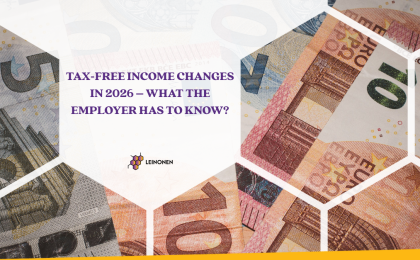Starting January 2025, Estonia has made important changes to payroll laws, affecting how workers’ salaries are taxed. The main changes are a higher personal income tax rate and increased payments into the second pension pillar. This article explains these changes and discusses other important factors that businesses need to be aware of to manage payroll correctly and follow the law.
Salary and Payment Terms
The Employment Contracts Act lets employers and employees decide together how wages are structured. Wages can be based on the number of hours worked (like hourly or monthly salary) or on the tasks completed (known as piece work). It is important that the employment contract clearly states the amount of wage to make everything clear for employees.
Here’s what should be considered when setting wages:
- The amount of work and time it takes.
- The complexity of the job.
- The working conditions.
- Any special situations, like working night shifts. Wages must be fair and should not discriminate based on gender.
For full-time workers, the wage must be at least the minimum wage set by the government. Wages should be paid in money, and this can include cash if both sides agree. Payments should be made at least once a month on a set payday mentioned in the employment contract. Employers can choose to pay wages more often, like every week, but not less than once a month. The payday should be on a specific date, such as the 5th of each month, or a specific day, like the first business day of each month. It should not be within a range of dates (for example, not between the 1st and 10th). If the payday is on a public holiday or a day off, the wages should be paid on the last working day before that. For instance, if payday is on a Sunday, the wages should be paid on the preceding Friday.
Salary Taxes and Contributions
Employers are required to pay and withhold certain taxes and contributions on the employee’s earnings.
| Payroll taxes | 2024 | 2025 | |
|---|---|---|---|
| Taxes withheld by the employer from the gross salary | Personal Income Tax (PIT) | 20% | 22% |
| Employee unemployment insurance tax | 1,6% | 1,6% | |
| Funded pension | 2% | 2%, 4% or 6% | |
| Taxes payable by the employer on the gross salary | Social tax | 33% | 33% |
| Employer unemployment insurance tax | 0,8% | 0,8% |
** To be eligible for health insurance in 2025, the total social tax from one or more authorization agreements and/or service contracts must be at least EUR 270.60, which is the amount based on a gross monthly wage of EUR 820.
Minimum Wage in 2025
Employees have a right to earn at least the minimum wage. In 2025, this is EUR 5.31 per hour (gross) or EUR 886 per month (gross) for full-time employees. For those working part-time, the minimum wage is adjusted based on the number of hours worked.
| Until 31.12.2024 | From 01.01.2025 | |
|---|---|---|
| Minimum monthly salary | 820 | 886 |
| Minimum hourly salary | 4,86 | 5,31 |
Key Tax Changes in 2025
Salary calculations, EUR
| 2024 | 2025 | |||
| % | EUR | % | EUR | |
| Gross salary | 2100 | 2100 | ||
| Used tax-free income minimum (basic exemption) | – | – | – | – |
| Employee unemployment insurance tax | 1,6% | 33.60 | 1,6% | 33.60 |
| Funded pension | 2% | 42.00 | 2% (4% or 6%) | 42.00 |
| Personal income tax | 20% | 404.88 | 22% | 445.37 |
| Net salary | 1619.52 | 1579.03 | ||
| Social tax | 33% | 693.00 | 33% | 693.00 |
| Employer unemployment insurance tax | 0,8% | 16.80 | 0,8% | 16.80 |
| Total Employer cost | 2809.80 | 2809.80 |
- Starting January 1, 2025, the income tax rate is 22%.
- The basic tax exemption varies by income, up to 654 euros monthly or 7,848 euros annually.
- The funded pension contribution rate is set at 2%, 4%, or 6%, based on the individual’s choice registered. If no choice is made, it defaults to 2%.
- From January 2024, individuals can opt to increase their second pension pillar contribution rate from 2% to 4% or 6%. Changes must be requested by November 30 each year, and the new rate applies from January 1 the following year.
Overtime, night work, work on public holidays regulation
In Estonia, overtime is defined as work performed beyond the agreed-upon working hours and requires a mutual agreement between the employer and the employee. Employers can compensate for overtime by giving either equivalent time off or monetary compensation, based on what has been agreed. When overtime is paid in money, the rate is 1.5 times the regular hourly wage.
For work carried out between 10 PM and 6 AM, employers must pay 1.25 times the regular wage unless the salary already includes compensation for night work. Work on public holidays is compensated at twice the regular wage, recognizing the special circumstances of these days.
Navigating Estonian Payroll Regulations
Understanding payroll regulations in Estonia is essential for both employers and employees. Following these guidelines ensures that employees are fairly compensated and that businesses comply with tax laws, contributing to a balanced work-life environment. By becoming well-versed in these regulations, businesses can handle payroll duties in Estonia with confidence and integrity.
If you have any questions about managing payroll in Estonia, please reach out to us using the contact information provided below.





